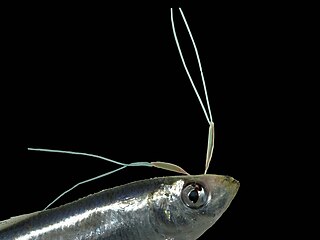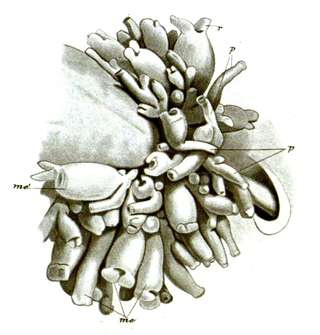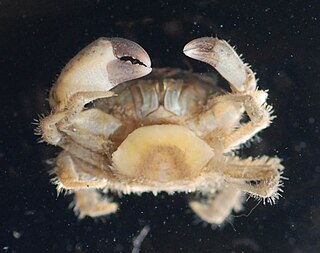
Parasitism is a close relationship between species, where one organism, the parasite, lives on or inside another organism, the host, causing it some harm, and is adapted structurally to this way of life. The entomologist E. O. Wilson characterised parasites as "predators that eat prey in units of less than one". Parasites include single-celled protozoans such as the agents of malaria, sleeping sickness, and amoebic dysentery; animals such as hookworms, lice, mosquitoes, and vampire bats; fungi such as honey fungus and the agents of ringworm; and plants such as mistletoe, dodder, and the broomrapes.

Copepods are a group of small crustaceans found in nearly every freshwater and saltwater habitat. Some species are planktonic, some are benthic, a number of species have parasitic phases, and some continental species may live in limnoterrestrial habitats and other wet terrestrial places, such as swamps, under leaf fall in wet forests, bogs, springs, ephemeral ponds, puddles, damp moss, or water-filled recesses of plants (phytotelmata) such as bromeliads and pitcher plants. Many live underground in marine and freshwater caves, sinkholes, or stream beds. Copepods are sometimes used as biodiversity indicators.

Sea lice are copepods of the family Caligidae within the order Siphonostomatoida. They are marine ectoparasites that feed on the mucus, epidermal tissue, and blood of host fish. The roughly 559 species in 37 genera include around 162 Lepeophtheirus and 268 Caligus species.
The whalesucker is a species of remora in the family Echeneidae, so named because it attaches itself exclusively to cetaceans. It is found worldwide in tropical and warm waters; in the Gulf of Mexico and western Atlantic Ocean, it occurs from Texas to Brazil, and in the eastern Pacific Ocean, it occurs from Vancouver Island to Chile. It is the rarest member of the remora family, though this may reflect more the uncommon collection of cetaceans in the wild rather than the whalesucker's actual abundance.

The slender suckerfish or lousefish is a rare species of remora found around the world in tropical and subtropical seas, in areas like the Atlantic, Pacific, and Indian Ocean, from depths from 1 to 100 meters deep.
The white suckerfish or mantasucker is a species of remora in the family Echeneidae, a group of elongated marine fish with adhesive discs for attaching to larger organisms. The distribution of this species is worldwide in warm open seas: it is found in the western Indian Ocean including Réunion and Mauritius, in the eastern Pacific Ocean from San Francisco to Chile, and in the western and eastern central Atlantic Ocean from Florida and the Gulf of Mexico to Brazil and St. Paul's Rocks.

The salmon louse is a species of copepod in the genus Lepeophtheirus. It is a sea louse, a parasite living mostly on salmon, particularly on Pacific and Atlantic salmon and sea trout, but is also sometimes found on the three-spined stickleback. It feeds on the mucus, skin and blood of the fish. Once detached, they can be blown by wind across the surface of the sea, like plankton. When they encounter a suitable marine fish host, they adhere themselves to the skin, fins, or gills of the fish, and feed on the mucus or skin. Sea lice only affect fish and are not harmful to humans.
Syndinium is a cosmopolitan genus of parasitic dinoflagellates that infest and kill marine planktonic species of copepods and radiolarians. Syndinium belongs to order Syndiniales, a candidate for the uncultured group I and II marine alveolates. The lifecycle of Syndinium is not well understood beyond the parasitic and zoospore stages.

Pennellidae is a family of parasitic copepods. When anchored on a host, they have a portion of the body on the outside of the host, whereas the remaining anterior part of the parasite is hidden inside tissues of the host.
Hemioniscus balani, a species of isopod crustacean, is a widespread parasitic castrator of barnacles in the northern Atlantic Ocean. Its range extends from Norway to the Atlantic coast of France, and as far west as Massachusetts. It is also commonly found on the Pacific coast of North America; it is not known if the Pacific and Atlantic populations are the same species, or if the Pacific population exists following human-assisted introduction.

Lernaeocera branchialis, sometimes called cod worm, is a parasite of marine fish, found mainly in the North Atlantic. It is a marine copepod which starts life as a small pelagic crustacean larva. It is among the largest of copepods, ranging in size from 2 to 3 millimetres when it matures as a copepodid larva to more than 40 mm as a sessile adult.

Hydrichthys is a genus of colonial marine hydrozoans formerly placed in the family Hydrichthyidae but is now included in the family Pandeidae. The polyps of members of this genus are parasitic. The polyp attaches itself to a fish, and in one species exhibits hyperparasitism by attaching itself to a copepod, itself the parasite of a fish.
Ellobiopsis is a genus of unicellular, ectoparasitic eukaryotes causing disease in crustaceans. This genus is widespread and has been found infecting copepods from both marine and freshwater ecosystems. parasitism has been seen to interfere with fertility in both sexes of copepods.
Pennella balaenopterae is a large ectoparasitic copepod specialising in parasitising marine mammals. It is the largest member of the genus Pennella, the other species of which are parasites of larger marine fish.

Pseudorhabdosynochus regius is a diplectanid monogenean parasitic on the gills of the mottled grouper .
Peniculisa is a genus of marine parasitic copepods in the family Pennellidae.

Hydrichthys sarcotretis is a species of colonial marine hydrozoans now included in the family Pandeidae. The polyps of members of this genus are parasitic and attach themselves to a fish. H. sarcotretis is a species that exhibits hyperparasitism by attaching itself to a copepod, itself the parasite of a fish.
Cardiodectes is a genus of copepods in the family Pennellidae. Species are parasites of fish.

Loxothylacus panopaei is a species of barnacle in the family Sacculinidae. It is native to the Gulf of Mexico and the Caribbean Sea. It is a parasitic castrator of small mud crabs in the family Panopeidae, mostly in the Gulf of Mexico, the Caribbean Sea and the eastern Atlantic Ocean.

Lernaeenicus sprattae is a species of copepod in the family Pennellidae. It is a parasite of the European sprat and certain other fish and is sometimes known as the sprat eye-maggot.









